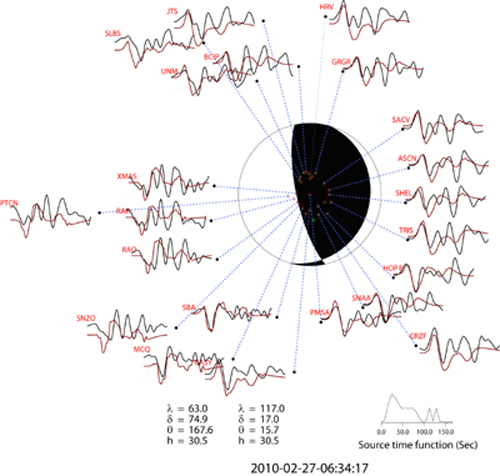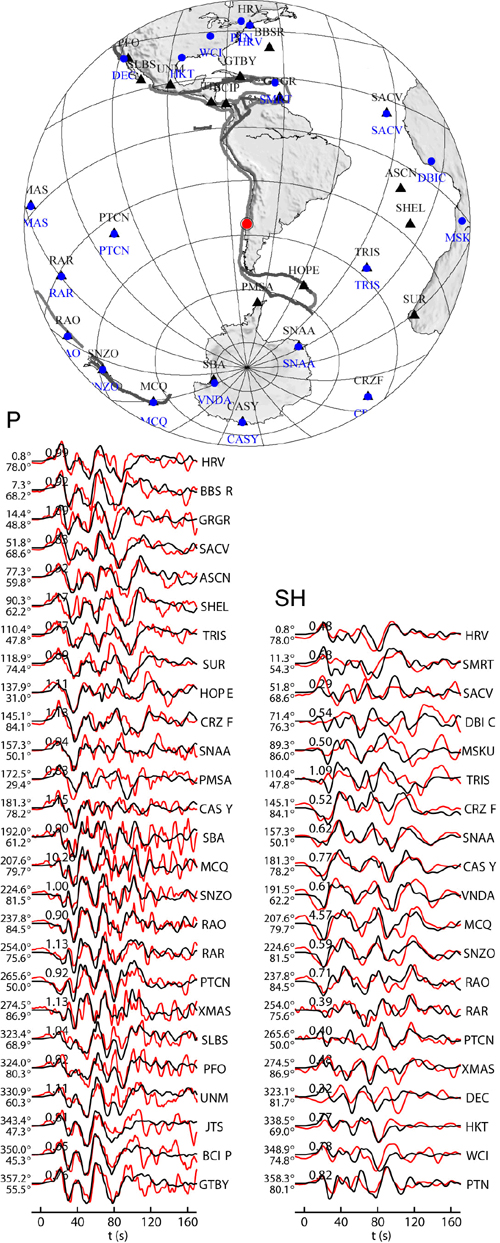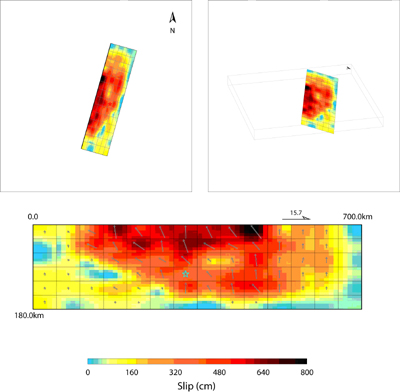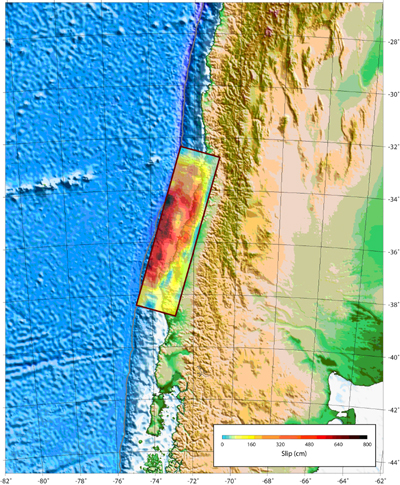2010年2月27日智利8.8级地震震源破裂过程初步结果
Preliminary result for Rupture Process of Feb. 27, 2010, M 8.8, Earthquake,Chile
王卫民1 赵连锋2 姚振兴2
1中国科学院青藏高原研究所,北京,100085
2中国科学院地质与地球物理研究所,北京,100029
地震发生后,从IRIS数据中心下载了地震数据资料用于研究地震震源机制和震源破裂过程。选取其中信噪比较高并且沿方位角分布比较均匀的26个远场P波波形(震中距位于30度之90度范围之内)和8个震中距较近的P波初动资料进行点源模型的波形反演;根据反演结果再利用26个远场P波波形并增加20个SH波波形资料用于震源过程反演。初始破裂点取USGS给出的震中位置。
计算得到的地震矩为1.1×1022Nm,Mw=8.6。最大滑动800cm。

图1 智利8.8级地震震源机制解
采用下半球投影,同时给出了点源模型的P波垂向位移理论图(红线)与资料(黑线)的拟合情况。“+”(绿)和“-”(兰)的圆圈表示P波初动极性及投影位置,红色圆圈表示用于波形反演的台站的投影位置。图形下方给出了两组节面解(左下,λ,δ,θ,h分别表示错动倾伏角、断层倾角、断层走向、震源深度)和点源模型的震源时间函数(右下)。
Figure 1 Focal mechanism of the M8.8 Chile earthquake.
Lower-hemisphere projection is used here. The observed P wave records (black line) and the synthetic seismogram (red line) based on the simple point model are compared. The green and blue circles with “+” and “-“ indicate the polarity of the direct P wave, and the red circles are the projection of the stations. The parameters of two possible fault planes are listed also, withl,d,q,h indicating the rake angle, dip angle, strike direction and source depth respectively. The obtained source time function are plotted.

图2 有限断层模型的远场P和SH波形拟合
上图为台站分布,其中黑色三角为选用P波记录的台站,蓝色圆为选用SH波记录的台站。
下图左列为P波垂向位移理论图(红线)与记录(黑线)的对比;右列为SH波切向位移理论图(红线)与记录(黑线)的对比;并给出每个记录的方位角(左上)、震中距(左下)、振幅比(上)和台站名(右)。
Figure 2 Comparison of the observed teleseismic P and SH records with the synthetic waveforms.
The location of the stations (upper panel): the black triangles and blue circles represent the stations used for P wave and SH wave inversion respectively. Comparison of observed (black) and synthetic waveforms (red) for P vertical components, and SH components are shown in the lower panel, the azimuth, epicentral distance, amplitude ratio and station name are also indicated.

图3 地震断层面上滑动分布
图中分别给出了有限断层模型的地表投影(左上)和三维示意图(右上)
Figure 3 Inverted slip distribution on the fault.
Surface projection of fault model ( up-left ) and 3D view of the fault model ( up-right ) are shown

图4 地震断层滑动分布投影
Fig. 4 The map shows the projection of slip distribution on the ground